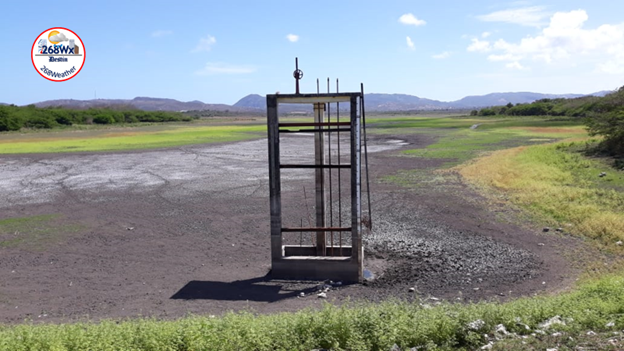The Antigua Public Utilities Authority (APUA) has confirmed that Potworks Reservoir, the island’s largest natural water catchment with a capacity of one billion gallons, has officially been tapped out as of April 15th.
The announcement comes less than two weeks after APUA’s April 2nd press release, which had projected the reservoir would last approximately three weeks before reaching the extraction threshold. The accelerated depletion has prompted the authority to fully activate its contingency plans to maintain water supply to affected communities.
Anazette Reynolds, the Corporate Communications Officer at APUA, explained the factors that contributed to the faster-than-expected depletion.
“The timeline that we provided on April 2nd was an estimated timeline based on a rough measurement our technician did on the existing amount at the time,” Reynolds said. “That was just an approximate estimate, and I will congratulate him because he was not that far off.”
Reynolds pointed to natural factors and high extraction rates for the quicker depletion. “Whenever the amount in the reservoir is depleted, one of the things that happen even on a daily basis is evaporation, and that will also do with the general heat. We were also extracting just about 900,000 gallons per day, which is a lot of water to come from a single source,” she noted.
The reservoir primarily services southeastern communities including American Road, All Saints Road, Belmont, Bethesda, Briggins, Buckleys, Folly Hill, Horsford Hill, John Hughes, Liberta, Ottos New Town, Patterson, Radio Range, St. Clair Heights, Swetes, Wallings, and parts of Falmouth.
Residents in these areas will now receive water from the Crabb’s Reverse Osmosis Plant, with some experiencing longer gaps between service or occasional interruptions as the system adjusts.
In response to questions about the readiness of additional reverse osmosis units from North Sound Management, Reynolds provided reassuring news.
“At this time, I’m pleased to say that they have been able to successfully do the testing and they are already producing almost 1 million gallons of water at North Sound,” she said. “Where it is located, it’s just next door to the Crabbs reverse osmosis plant, so it’s just a matter of it transitioning into the transmission and distribution lines and feeding out to customers.”
The North Sound Management facility had previously contributed an average of 300,000 imperial gallons per day to the APUA distribution network. The additional reverse osmosis units were expected to increase capacity by a further 1,000,000 imperial gallons per day, with testing commencing on April 7th.
With the Crabb’s facility now serving as the primary water source for affected communities, APUA is implementing a rotation system. “Crabb’s generally provide water to maybe about 60-65% of our customers,” Reynolds explained. “Our technicians and engineers measure on a daily basis the amount of water that is being produced, and it is rotated to share amongst different communities.”
The Corporate Communications Officer, who was candid about the current limitations, stated that “we are not producing a surplus of water to meet the daily demand, so it does mean that there will be gaps in between service days, which is expected. However, we are working on distribution and operational distribution to ensure the amount of water is distributed in an equitable way.”
APUA is emphasizing water conservation and preparedness and Reynolds reminded residents that building codes in Antigua require households to have rainwater catchment systems.
“Dating back many years, we do know that Antigua has been known for drought,” she said. “We are still asking and encouraging people to store water because even if we build out — and when we build out more production reverse osmosis plants, these plants have to go through maintenance periods.”
The utilities company recommends that households maintain a water storage capacity of at least 60 gallons per person, enough to last a minimum of three days in case of interruptions.
“It is absolutely necessary for households to have an adequate amount of water that they do store,” Reynolds stressed. “We strongly encourage persons to invest in what they can afford, at least to meet that amount.”
For residents looking to conserve water during this period, Reynolds offered practical advice: “There’s some [conservation measures] as simple as turning off the tap when you’re brushing your teeth, turning off the tap if you’re doing dishes and either plugging your sink or using a basin, short showers and utilizing a bucket,” she suggested. “We could also reuse our grey water to water our plants.”
APUA’s current water conservation campaign is themed “Water Works Wonders, Every Drop Counts, Preserve It.”




